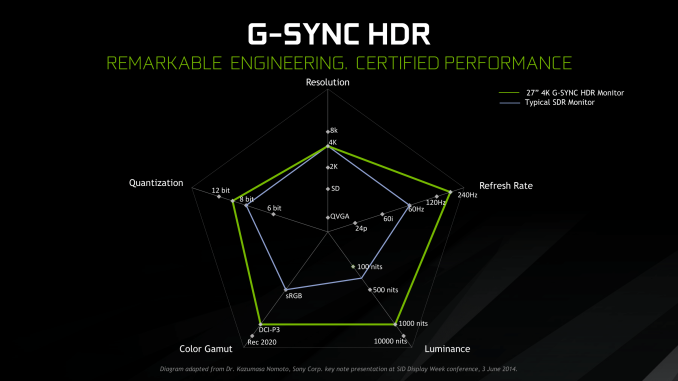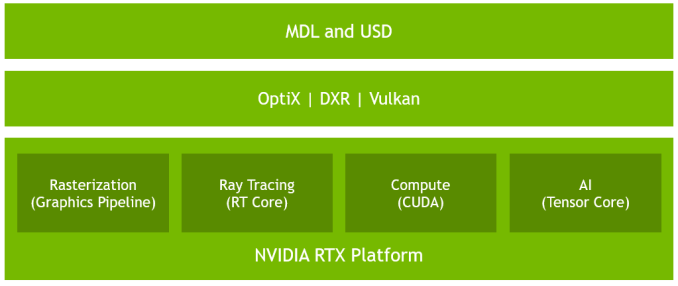The NVIDIA GeForce RTX 2080 Ti & RTX 2080 Founders Edition Review: Foundations For A Ray Traced Future
by Nate Oh on September 19, 2018 5:15 PM EST- Posted in
- GPUs
- Raytrace
- GeForce
- NVIDIA
- DirectX Raytracing
- Turing
- GeForce RTX
Meet The New Future of Gaming: Different Than The Old One
Up until last month, NVIDIA had been pushing a different, more conventional future for gaming and video cards, perhaps best exemplified by their recent launch of 27-in 4K G-Sync HDR monitors, courtesy of Asus and Acer. The specifications and display represented – and still represents – the aspired capabilities of PC gaming graphics: 4K resolution, 144 Hz refresh rate with G-Sync variable refresh, and high-quality HDR. The future was maxing out graphics settings on a game with high visual fidelity, enabling HDR, and rendering at 4K with triple-digit average framerate on a large screen. That target was not achievable by current performance, at least, certainly not by single-GPU cards. In the past, multi-GPU configurations were a stronger option provided that stuttering was not an issue, but recent years have seen both AMD and NVIDIA take a step back from CrossFireX and SLI, respectively.
Particularly with HDR, NVIDIA expressed a qualitative rather than quantitative enhancement in the gaming experience. Faster framerates and higher resolutions were more known quantities, easily demoed and with more intuitive benefits – though in the past there was the perception of 30fps as cinematic, and currently 1080p still remains stubbornly popular – where higher resolution means more possibility for details, higher even framerates meant smoother gameplay and video. Variable refresh rate technology soon followed, resolving the screen-tearing/V-Sync input lag dilemma, though again it took time to catch on to where it is now – nigh mandatory for a higher-end gaming monitor.
For gaming displays, HDR was substantively different than adding graphical details or allowing smoother gameplay and playback, because it meant a new dimension of ‘more possible colors’ and ‘brighter whites and darker blacks’ to gaming. Because HDR capability required support from the entire graphical chain, as well as high-quality HDR monitor and content to fully take advantage, it was harder to showcase. Added to the other aspects of high-end gaming graphics and pending the further development of VR, this was the future on the horizon for GPUs.
But today NVIDIA is switching gears, going to the fundamental way computer graphics are modelled in games today. Of the more realistic rendering processes, light can be emulated as rays that emit from their respective sources, but computing even a subset of the number of rays and their interactions (reflection, refraction, etc.) in a bounded space is so intensive that real time rendering was impossible. But to get the performance needed to render in real time, rasterization essentially boils down 3D objects as 2D representations to simplify the computations, significantly faking the behavior of light.
It’s on real time ray tracing that NVIDIA is staking its claim with GeForce RTX and Turing’s RT Cores. Covered more in-depth in our architecture article, NVIDIA’s real time ray tracing implementation takes all the shortcuts it can get, incorporating select real time ray tracing effects with significant denoising but keeping rasterization for everything else. Unfortunately, this hybrid rendering isn’t orthogonal to the previous concepts. Now, the ultimate experience would be hybrid rendered 4K with HDR support at high, steady, and variable framerates, though GPUs didn’t have enough performance to get to that point under traditional rasterization.
There’s a still a performance cost incurred with real time ray tracing effects, except right now only NVIDIA and developers have a clear idea of what it is. What we can say is that utilizing real time ray tracing effects in games may require sacrificing some or all three of high resolution, ultra high framerates, and HDR. HDR is limited by game support more than anything else. But the first two have arguably minimum performance standards when it comes to modern high-end gaming on PC – anything under 1080p is completely unpalatable, and anything under 30fps or more realistically 45 to 60fps hurts the playability. Variable refresh rate can mitigate the latter and framedrops are temporary, but low resolution is forever.
Ultimately, the real time ray tracing support needs to be implemented by developers via a supporting API like DXR – and many have been working hard on doing so – but currently there is no public timeline of application support for real time ray tracing, Tensor Core accelerated AI features, and Turing advanced shading. The list of games with support for Turing features - collectively called the RTX platform - will be available and updated on NVIDIA's site.













337 Comments
View All Comments
mapesdhs - Thursday, September 27, 2018 - link
Does the site earn anything from your reading their articles? Just curious.sing_electric - Thursday, September 20, 2018 - link
I really wonder how well raytracing will be implemented in the next 1-2 years. My bet is that for many of the titles Nvidia's announced, the effects will be limited and sort of gimicky, and the real benefits will come with titles that are starting development now (or, more likely, in a few months, when devs can look at how the 1st attempts at using RT faired).If my hunch is right, then that means that the RT features are likely to be of little practical use in this generation, since the real benefits won't come until some point after Nvidia's next-gen (7nm? 5?) chips come out with much-improved performance.
MadManMark - Thursday, September 20, 2018 - link
It sounds like the 2080 TI at maybe 1440 might be viable for RT. But yeah, for the most part this is about the future, and starting to get some games out there so for future releses there is not the "chicken & egg" problem they have now (no games to use it for, but reason there are no games is there are no cards to use it).Nvidia clearly sacrificing short-term profitability to establish this base; notice how the 2080 is both priced & performs about the same as the 1080 Ti. With the larger die size despite 12nmFF, driver development costs, etc, there is little doubt in my mind that Nvidia will be making a bigger margin on the 1080 Ti than the 2080. But they want to make it cheap enough so that, even if there is little to gain RIGHT NOW from buying 2080 instead fo 1080 Ti, there is also little lost either.
milkod2001 - Thursday, September 20, 2018 - link
It will have to be AMD who also jumps on raytracing thing first then maybe game developers will take it seriously.MadManMark - Thursday, September 20, 2018 - link
"Bartender, I'll have what milkod2001's having!" ;)El Sama - Thursday, September 20, 2018 - link
RTX 2080 not worth buying right now, 1080ti is cheaper (lol), cooler and performs equal. RTX 2080ti is a 1200+ Card that is around 60% price increase from 1080ti for a 25-28% performance increase? How is that a good purchase? Neither of them are worth buying right now.Toadster - Thursday, September 20, 2018 - link
decisions - 24 monthly payments for an iPhone XS Max? or GTX 2080Ti :)milkod2001 - Thursday, September 20, 2018 - link
Get iPhone if you want to be cool guy, you cannot put RTX 2080ti into your pocket :)Arbie - Thursday, September 20, 2018 - link
THANK YOU for the Ashes of the Singularity benchmark results. The deltas may not translate to other games but show me exactly what to expect from an upgrade.darckhart - Thursday, September 20, 2018 - link
But NVIDIA's key features - such as real time ray tracing and DLSS - aren't being utilized by any games right at launch. In fact, it's not very clear at all when those games might arrive, because NVIDIA ultimately is reliant on developers here.In the Star Wars Reflections demo, we measured the RTX 2080 Ti Founders Edition managing around a 14.7fps average at 4K and 31.4fps average at 1440p when rendering the real time ray traced scene. With DLSS enabled, it jumps to 33.8 and 57.2fps
Direct quotes from article. Price premium for NV tech that (1) will not be in games at launch and may have months of buggy implementation from early adoption and may not have widespread adoption, (2) needs extreme help from DLSS to have usable framerates. Should've been named DTX not RTX.